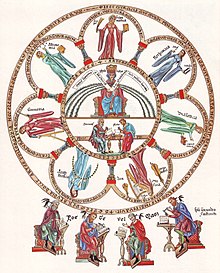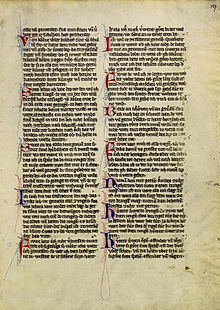manuscript

In library studies or edition philology, manuscripts or handwriting are handwritten books , letters or other forms of publication (from the Latin manu scriptum , 'handwritten'; abbreviation: Ms. ).
In the strict sense is understood as by manual writing with ink or other coloring agents on papyrus , palm leaves , birch bark , parchment , pieces of wood or paper placed works.
Nowadays, machine-written print templates (actually: typescripts or machine manuscripts) are more colloquially referred to as manuscripts.
When television and radio reports are made available in printed form or are offered for downloading from the Internet , one speaks of a broadcast manuscript.
history
The literature of antiquity and the Middle Ages is almost exclusively handwritten on papyrus, parchment and paper.
Texts from the Middle Ages are often summarized in collective manuscripts . The idea of the individual book as a typical form of existence of a “work” as a monograph did not yet exist in its present form. The code was a material storage and decoration form of various written documents. Sometimes the owners of such codices also tried to collect as completely as possible the material or “knowledge” on a certain subject or topic (e.g. courtly knight literature). A well-known example of this is the Ambras book of heroes from the beginning of the 16th century. An example from the middle of the 14th century is the collective manuscript with the signature Ms. germ. Quart. 284 of the Staatsbibliothek zu Berlin , which contains, among other things, two texts of the Tristan material: The Tristan of the poet Gottfried von Strasbourg and Ulrichs von Türheim Tristan continuation. The book Science and the codicology explore the different conceptual or random investment principles of mixed manuscripts and manuscript collections.
Until the invention of printing , manuscripts were the only form of written publication , that is, the texts had to be copied in order to be distributed. This was true from the appearance of writing to the invention of printing by Gutenberg around 1450, i.e. for more than three millennia. If one considers the coincidences of the course of history, the material and the spiritual, and the endangerment of everything written through the centuries, it is astonishing, according to Martin Bodmer , that no more has been lost. Despite the threat from the forces of nature and human work, the greatest spiritual treasures could be preserved, albeit in a roundabout way: there would be no other explanation for the rescue of ancient literature through such heterogeneous intermediaries as the Arab scholars and Christian monks. Your copies have, however, moved us further and further away from the original texts, and astute research is required to restore the real wording from all the fragments that can be understood. Even then, the oldest document is often centuries away from the author. Researching the ways in which a text is distributed is the task of text transmission.
Manuscripts allow various conclusions to be drawn about the creation process and the authenticity of a text. Modern text creation on the computer, on the other hand, often only leaves the finished document as a “speechless document”.
Famous manuscripts
Historical
(sorted chronologically)
- Donaueschingen manuscript ( Nibelungenlied ), around 1220
- Codex Manesse , around 1300
- Manasses Chronicle , between 1345 and 1347
- Codex Nuttall , 14th century ( Mixtec )
- Hergest Red Book , 14th Century ( Welsh )
- House book (Wolfegg Castle) , after 1480
- Voynich manuscript , around 15th century
- Ambraser Heldenbuch , 16th century
- Carte Manuscripts , 18th century
Religious
(sorted chronologically)

- Dead Sea Scrolls , 3rd Century BC BC to 1st century AD
- Nag Hammadi writings , 3rd / 4th centuries century
- Codex Sinaiticus , 4th century
- Codex Vaticanus , 4th century
- Codex Alexandrinus , 5th century
- Codex Argenteus , 6th century
- Faddan More Psalter , 7./8. century
- Book of Armagh , 9th century
- Book of Kells , 9th century
- Etchmiadzin Gospels , 989
- Fridolin's vita , 10th century
- Freising monuments , 10./11. century
- Millstatt manuscript 11./12. century
- Henry the Lion Gospel Book 12th Century
- Hortus Deliciarum by Herrad von Landsberg , 12th century
- Tetra Gospel Book of Tsar Ivan Alexander , 14th century
Scientific
- The manuscripts of Leonardo da Vinci , the 15th to 16th century
- Leibniz correspondence , 17th to 18th centuries
Cultural
- Correspondance littéraire, philosophique et critique , from 1753 to 1790
Standard manuscripts
Publishers often require authors to adhere to certain formal guidelines for their submitted manuscripts. A standard manuscript page for example, has 30 lines of 60 characters (including spaces) and should be 1.5 times or double line spacing and a 12- point - font to use. A manuscript written according to these specifications contains around 1800 characters per page, which varies depending on the font.
These strict formal requirements for typescripts are gradually being replaced by precise information on the number of characters and prepared electronic format templates for authors.
See also
literature
- Handwriting . In: Meyers Konversations-Lexikon . 4th edition. Volume 8, Verlag des Bibliographisches Institut, Leipzig / Vienna 1885–1892, p. 114.
- Lonni Bahmer: speech manuscript . In: Gert Ueding (Hrsg.): Historical dictionary of rhetoric . Darmstadt: WBG 1992ff., Vol. 10 (2011), Col. 1029-1039 (also deals with the typescript ).
- Peter Jörg Becker and Eef Overgaauw (eds.): Aderlass und Seelentrost. The transmission of German texts in the Spiegel Berlin manuscripts and incunabula. Mainz 2003
- History of the text transmission of ancient and medieval literature , ed. by Martin Bodmer ; Atlantis Verlag, Zurich 1961–1964, 2 volumes, of which volume 1: Ancient and medieval books and writing, the history of ancient literature , by Herbert Hunger a. a .; Volume 2: History of transmission of medieval literature , by Karl Langosch a. a .; 623 + 843 pages, ill.
- Joachim Kirchner : Germanistic Manuscript Practice: A Textbook for Students of German Philology. CH Beck, Munich 1950; 2nd edition, ibid. 1967.
- Lotte Kurras: The German medieval manuscripts (= catalogs of the Germanisches Nationalmuseum Nürnberg. The manuscripts of the Germanisches Nationlmuseum Nürnberg. 1). 2 volumes. Wiesbaden 1974–1980.
Directories
- http://www.manuscripta-mediaevalia.de Manuscripta Mediaevalia (with digital copies)
- http://www.handschriftencensus.de Handschriftencensus
- Mediaevum.de
- Catalog of the German-language illustrated manuscripts of the Middle Ages (KdiH) - scientific development of text-image relationships
- Virtual Library: manuscript databases, catalogs and directories
- Resources for Austrian manuscript collections
- Bibliotheca Neerlandica Manuscripta (BNM)
- Manuscript Cultures in Asia, Africa and Europe, Hamburg (CSMC)
- Medieval Manuscripts in Dutch Collections
Web links
- Signs - Books - Networks , virtual exhibition of the German Museum of Books and Writing, including a thematic module on medieval manuscript culture
Individual evidence
- ↑ Book review of 'Gandharan Buddhism: Archeology, Art, and Texts'; by Pia Brancaccio and Kurt Behrendt pdf
- ^ The British Library Kharosthi Fragments; Richard Salomon; washington.edu
- ^ Richard Sperl: Cognitive value and cognitive limits of the materiality of the text witnesses in the edition of scientific texts. Using the example of the Marx-Engels Complete Edition. In: Martin Schubert (Ed.): Materiality in Editionswissenschaft. Walter de Gruyter, Berlin / New York 2010, ISBN 978-3-11-023130-4 , pp. 193–208, here: p. 193.
- ↑ Eltjo Buringh, Jan Luiten van Zanden: Charting the "Rise of the West": Manuscripts and Printed Books in Europe. A Long-Term Perspective from the Sixth through Eighteenth Centuries. In: The Journal of Economic History , Vol. 69, No. 2 (2009), pp. 409–445 (416, plate 1)
- ↑ The entry in the manuscript census provides a complete overview of all texts contained in the manuscript ; more details on provenance and text program: Renate Schipke: Gottfried von Straßburg: Tristan u. a. , in: Bloodletting and comfort of soul. The transmission of German texts in the Spiegel Berliner manuscripts and incunabula, ed. by Peter Jörg Becker and Eef Overgaauw (Berlin State Library - Preußischer Kulturbesitz. Exhibition catalogs NF 48), Mainz 2003, pp. 70–73 (No. 28).
- ↑ Martin Bodmer in the foreword to the history of the text transmission of ancient and medieval literature , ed. by Martin Bodmer; Atlantis Verlag, Zurich 1961–1964, Volume 1, pp. 17–24
- ↑ Martin Bodmer in the foreword to the history of the text transmission of ancient and medieval literature , ed. by Martin Bodmer; Atlantis Verlag, Zurich 1961–1964, Volume 1, pp. 17–24
- ^ Walter Rösner-Kraus: Withdrawal of the manuscript. In: Specialized prose research - Crossing borders. Volume 8/9, 2012/2013 (2014), p. 551.

